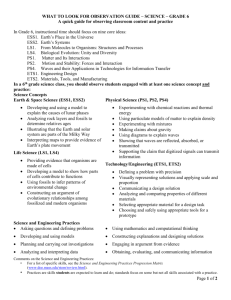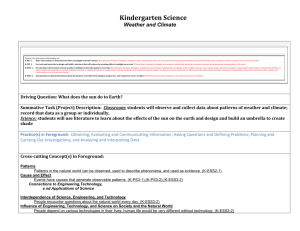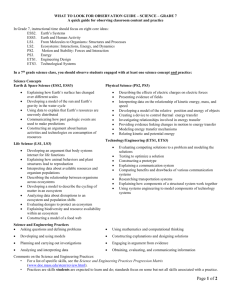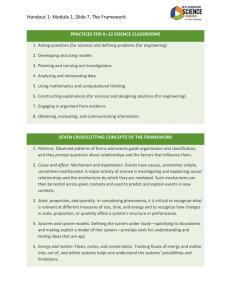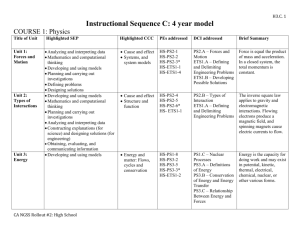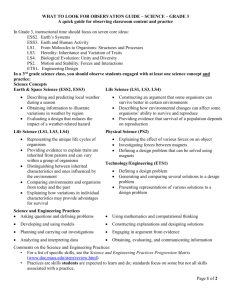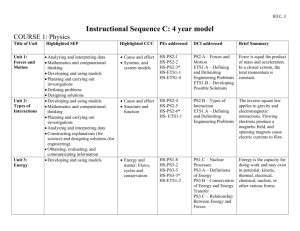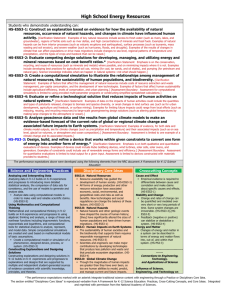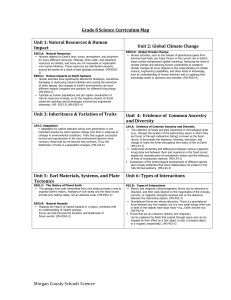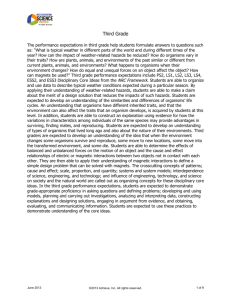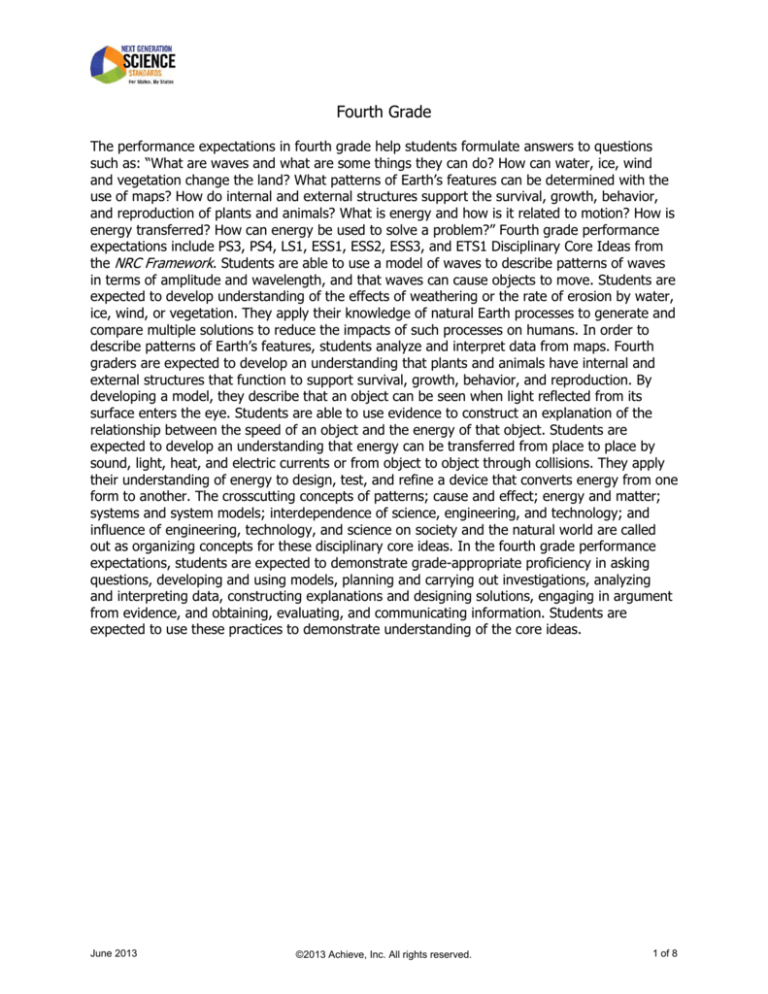
Fourth Grade
The performance expectations in fourth grade help students formulate answers to questions
such as: “What are waves and what are some things they can do? How can water, ice, wind
and vegetation change the land? What patterns of Earth’s features can be determined with the
use of maps? How do internal and external structures support the survival, growth, behavior,
and reproduction of plants and animals? What is energy and how is it related to motion? How is
energy transferred? How can energy be used to solve a problem?” Fourth grade performance
expectations include PS3, PS4, LS1, ESS1, ESS2, ESS3, and ETS1 Disciplinary Core Ideas from
the NRC Framework. Students are able to use a model of waves to describe patterns of waves
in terms of amplitude and wavelength, and that waves can cause objects to move. Students are
expected to develop understanding of the effects of weathering or the rate of erosion by water,
ice, wind, or vegetation. They apply their knowledge of natural Earth processes to generate and
compare multiple solutions to reduce the impacts of such processes on humans. In order to
describe patterns of Earth’s features, students analyze and interpret data from maps. Fourth
graders are expected to develop an understanding that plants and animals have internal and
external structures that function to support survival, growth, behavior, and reproduction. By
developing a model, they describe that an object can be seen when light reflected from its
surface enters the eye. Students are able to use evidence to construct an explanation of the
relationship between the speed of an object and the energy of that object. Students are
expected to develop an understanding that energy can be transferred from place to place by
sound, light, heat, and electric currents or from object to object through collisions. They apply
their understanding of energy to design, test, and refine a device that converts energy from one
form to another. The crosscutting concepts of patterns; cause and effect; energy and matter;
systems and system models; interdependence of science, engineering, and technology; and
influence of engineering, technology, and science on society and the natural world are called
out as organizing concepts for these disciplinary core ideas. In the fourth grade performance
expectations, students are expected to demonstrate grade-appropriate proficiency in asking
questions, developing and using models, planning and carrying out investigations, analyzing
and interpreting data, constructing explanations and designing solutions, engaging in argument
from evidence, and obtaining, evaluating, and communicating information. Students are
expected to use these practices to demonstrate understanding of the core ideas.
June 2013
©2013 Achieve, Inc. All rights reserved.
1 of 8
4-PS3 Energy
4-PS3 Energy
Students who demonstrate understanding can:
4-PS3-1. Use evidence to construct an explanation relating the speed of an object to the energy of that object.
[Assessment
Boundary: Assessment does not include quantitative measures of changes in the speed of an object or on any precise or quantitative definition of energy.]
4-PS3-2.
Make observations to provide evidence that energy can be transferred from place to place by sound, light, heat, and
electric currents. [Assessment Boundary: Assessment does not include quantitative measurements of energy.]
Ask questions and predict outcomes about the changes in energy that occur when objects collide. [Clarification Statement:
4-PS3-3.
Emphasis is on the change in the energy due to the change in speed, not on the forces, as objects interact.] [Assessment Boundary: Assessment does not include
quantitative measurements of energy.]
Apply scientific ideas to design, test, and refine a device that converts energy from one form to another.* [Clarification
Statement: Examples of devices could include electric circuits that convert electrical energy into motion energy of a vehicle, light, or sound; and, a passive solar heater
that converts light into heat. Examples of constraints could include the materials, cost, or time to design the device.] [Assessment Boundary: Devices should be limited
to those that convert motion energy to electric energy or use stored energy to cause motion or produce light or sound.]
The performance expectations above were developed using the following elements from the NRC document A Framework for K-12 Science Education:
4-PS3-4.
Science and Engineering Practices
Disciplinary Core Ideas
Crosscutting Concepts
Asking Questions and Defining Problems
Asking questions and defining problems in grades 3–5
builds on grades K–2 experiences and progresses to
specifying qualitative relationships.
Ask questions that can be investigated and predict
reasonable outcomes based on patterns such as cause
and effect relationships. (4-PS3-3)
Planning and Carrying Out Investigations
Planning and carrying out investigations to answer
questions or test solutions to problems in 3–5 builds on K–
2 experiences and progresses to include investigations that
control variables and provide evidence to support
explanations or design solutions.
Make observations to produce data to serve as the
basis for evidence for an explanation of a
phenomenon or test a design solution. (4-PS3-2)
Constructing Explanations and Designing Solutions
Constructing explanations and designing solutions in 3–5
builds on K–2 experiences and progresses to the use of
evidence in constructing explanations that specify
variables that describe and predict phenomena and in
designing multiple solutions to design problems.
Use evidence (e.g., measurements, observations,
patterns) to construct an explanation. (4-PS3-1)
Apply scientific ideas to solve design problems. (4PS3-4)
PS3.A: Definitions of Energy
The faster a given object is moving, the more energy it possesses. (4PS3-1)
Energy can be moved from place to place by moving objects or
through sound, light, or electric currents. (4-PS3-2),(4-PS3-3)
PS3.B: Conservation of Energy and Energy Transfer
Energy is present whenever there are moving objects, sound, light, or
heat. When objects collide, energy can be transferred from one object
to another, thereby changing their motion. In such collisions, some
energy is typically also transferred to the surrounding air; as a result,
the air gets heated and sound is produced. (4-PS3-2),(4-PS3-3)
Light also transfers energy from place to place. (4-PS3-2)
Energy can also be transferred from place to place by electric currents,
which can then be used locally to produce motion, sound, heat, or
light. The currents may have been produced to begin with by
transforming the energy of motion into electrical energy. (4-PS3-2),(4PS3-4)
PS3.C: Relationship Between Energy and Forces
When objects collide, the contact forces transfer energy so as to
change the objects’ motions. (4-PS3-3)
PS3.D: Energy in Chemical Processes and Everyday Life
The expression “produce energy” typically refers to the conversion of
stored energy into a desired form for practical use. (4-PS3-4)
ETS1.A: Defining Engineering Problems
Possible solutions to a problem are limited by available materials and
resources (constraints). The success of a designed solution is
determined by considering the desired features of a solution (criteria).
Different proposals for solutions can be compared on the basis of how
well each one meets the specified criteria for success or how well each
takes the constraints into account. (secondary to 4-PS3-4)
Energy and Matter
Energy can be transferred in various
ways and between objects. (4-PS3-1),(4PS3-2),(4-PS3-3),(4-PS3-4)
---------------------------------------------
Connections to Engineering, Technology,
and Applications of Science
Influence of Science, Engineering and
Technology on Society and the Natural
World
Engineers improve existing technologies
or develop new ones. (4-PS3-4)
----------------------------------------------
Connections to Nature of Science
Science is a Human Endeavor
Most scientists and engineers work in
teams. (4-PS3-4)
Science affects everyday life. (4-PS3-4)
Connections to other DCIs in fourth grade: N/A
Articulation of DCIs across grade-levels: K.PS2.B (4-PS3-3); K.ETS1.A (4-PS3-4); 2.ETS1.B (4-PS3-4); 3.PS2.A (4-PS3-3); 5.PS3.D (4-PS3-4); 5.LS1.C (4-PS3-4); MS.PS2.A (4-PS33); MS.PS2.B (4-PS3-2); MS.PS3.A (4-PS3-1),(4-PS3-2),(4-PS3-3),(4-PS3-4); MS.PS3.B (4-PS3-2),(4-PS3-3),(4-PS3-4); MS.PS3.C (4-PS3-3); MS.PS4.B (4-PS3-2); MS.ETS1.B (4PS3-4); MS.ETS1.C (4-PS3-4)
Common Core State Standards Connections:
ELA/Literacy –
RI.4.1
RI.4.3
RI.4.9
W.4.2
W.4.7
W.4.8
W.4.9
Mathematics –
4.OA.A.3
Refer to details and examples in a text when explaining what the text says explicitly and when drawing inferences from the text. (4-PS3-1)
Explain events, procedures, ideas, or concepts in a historical, scientific, or technical text, including what happened and why, based on specific information in the text. (4PS3-1)
Integrate information from two texts on the same topic in order to write or speak about the subject knowledgeably. (4-PS3-1)
Write informative/explanatory texts to examine a topic and convey ideas and information clearly. (4-PS3-1)
Conduct short research projects that build knowledge through investigation of different aspects of a topic. (4-PS3-2),(4-PS3-3),(4-PS3-4)
Recall relevant information from experiences or gather relevant information from print and digital sources; take notes and categorize information, and provide a list of
sources. (4-PS3-1),(4-PS3-2),(4-PS3-3),(4-PS3-4)
Draw evidence from literary or informational texts to support analysis, reflection, and research. (4-PS3-1)
Solve multistep word problems posed with whole numbers and having whole-number answers using the four operations, including problems in which remainders must be
interpreted. Represent these problems using equations with a letter standing for the unknown quantity. Assess the reasonableness of answers using mental computation
and estimation strategies including rounding. (4-PS3-4)
*The performance expectations marked with an asterisk integrate traditional science content with engineering through a Practice or Disciplinary Core Idea.
The section entitled “Disciplinary Core Ideas” is reproduced verbatim from A Framework for K-12 Science Education: Practices, Cross-Cutting Concepts, and Core Ideas. Integrated
and reprinted with permission from the National Academy of Sciences.
June 2013
©2013 Achieve, Inc. All rights reserved.
2 of 8
4-PS4 Waves and their Applications in Technologies for Information Transfer
4-PS4 Waves and their Applications in Technologies for Information Transfer
Students who demonstrate understanding can:
4-PS4-1. Develop a model of waves to describe patterns in terms of amplitude and wavelength and that waves can cause
objects to move. [Clarification Statement: Examples of models could include diagrams, analogies, and physical models using wire to illustrate wavelength and
amplitude of waves.] [Assessment Boundary: Assessment does not include interference effects, electromagnetic waves, non-periodic waves, or quantitative models of
amplitude and wavelength.]
4-PS4-2. Develop a model to describe that light reflecting from objects and entering the eye allows objects to be seen.
[Assessment Boundary: Assessment does not include knowledge of specific colors reflected and seen, the cellular mechanisms of vision, or how the retina works.]
4-PS4-3. Generate and compare multiple solutions that use patterns to transfer information.*
[Clarification Statement: Examples of
solutions could include drums sending coded information through sound waves, using a grid of 1’s and 0’s representing black and white to send information about a
picture, and using Morse code to send text.]
The performance expectations above were developed using the following elements from the NRC document A Framework for K-12 Science Education:
Science and Engineering Practices
Disciplinary Core Ideas
Crosscutting Concepts
Developing and Using Models
Modeling in 3–5 builds on K–2 experiences and progresses
to building and revising simple models and using models to
represent events and design solutions.
Develop a model using an analogy, example, or abstract
representation to describe a scientific principle. (4-PS41)
Develop a model to describe phenomena. (4-PS4-2)
Constructing Explanations and Designing Solutions
Constructing explanations and designing solutions in 3–5
builds on K–2 experiences and progresses to the use of
evidence in constructing explanations that specify variables
that describe and predict phenomena and in designing
multiple solutions to design problems.
Generate and compare multiple solutions to a problem
based on how well they meet the criteria and
constraints of the design solution. (4-PS4-3)
PS4.A: Wave Properties
Patterns
Waves, which are regular patterns of motion, can be made
Similarities and differences in patterns can be
in water by disturbing the surface. When waves move
used to sort and classify natural phenomena.
across the surface of deep water, the water goes up and
(4-PS4-1)
down in place; there is no net motion in the direction of
Similarities and differences in patterns can be
the wave except when the water meets a beach. (Note:
used to sort and classify designed products. (4This grade band endpoint was moved from K–2.) (4-PS4PS4-3)
1)
Cause and Effect
Waves of the same type can differ in amplitude (height of
Cause and effect relationships are routinely
the wave) and wavelength (spacing between wave peaks).
identified. (4-PS4-2)
(4-PS4-1)
PS4.B: Electromagnetic Radiation
-------------------------------------------------- An object can be seen when light reflected from its surface
Connections to Engineering, Technology,
enters the eyes. (4-PS4-2)
and Applications of Science
PS4.C: Information Technologies and Instrumentation
Digitized information can be transmitted over long
Interdependence of Science, Engineering,
distances without significant degradation. High-tech
and Technology
devices, such as computers or cell phones, can receive and
Knowledge of relevant scientific concepts and
------------------------------------------------decode information—convert it from digitized form to
research findings is important in engineering.
Connections to Nature of Science
voice—and vice versa. (4-PS4-3)
(4-PS4-3)
ETS1.C: Optimizing The Design Solution
Scientific Knowledge is Based on Empirical Evidence
Different solutions need to be tested in order to determine
Science findings are based on recognizing patterns. (4which of them best solves the problem, given the criteria
PS4-1)
and the constraints. (secondary to 4-PS4-3)
Connections to other DCIs in fourth grade: 4.PS3.A (4-PS4-1); 4.PS3.B (4-PS4-1); 4.ETS1.A (4-PS4-3)
Articulation of DCIs across grade-levels: K.ETS1.A (4-PS4-3); 1.PS4.B (4-PS4-2); 1.PS4.C (4-PS4-3); 2.ETS1.B (4-PS4-3); 2.ETS1.C (4-PS4-3); 3.PS2.A (4-PS4-3); MS.PS4.A
(4-PS4-1); MS.PS4.B (4-PS4-2); MS.PS4.C (4-PS4-3); MS.LS1.D (4-PS4-2); MS.ETS1.B (4-PS4-3)
Common Core State Standards Connections:
ELA/Literacy –
RI.4.1
RI.4.9
SL.4.5
Refer to details and examples in a text when explaining what the text says explicitly and when drawing inferences from the text. (4-PS4-3)
Integrate information from two texts on the same topic in order to write or speak about the subject knowledgeably. (4-PS4-3)
Add audio recordings and visual displays to presentations when appropriate to enhance the development of main ideas or themes. (4-PS4-1),(4-PS4-2)
MP.4
4.G.A.1
Model with mathematics. (4-PS4-1),(4-PS4-2)
Draw points, lines, line segments, rays, angles (right, acute, obtuse), and perpendicular and parallel lines. Identify these in two-dimensional figures. (4-PS4-1),(4-PS4-
Mathematics –
2)
*The performance expectations marked with an asterisk integrate traditional science content with engineering through a Practice or Disciplinary Core Idea.
The section entitled “Disciplinary Core Ideas” is reproduced verbatim from A Framework for K-12 Science Education: Practices, Cross-Cutting Concepts, and Core Ideas. Integrated
and reprinted with permission from the National Academy of Sciences.
June 2013
©2013 Achieve, Inc. All rights reserved.
3 of 8
4-LS1 From Molecules to Organisms: Structures and Processes
4-LS1 From Molecules to Organisms: Structures and Processes
Students who demonstrate understanding can:
4-LS1-1. Construct an argument that plants and animals have internal and external structures that function to support
survival, growth, behavior, and reproduction. [Clarification Statement: Examples of structures could include thorns, stems, roots, colored petals,
heart, stomach, lung, brain, and skin.] [Assessment Boundary: Assessment is limited to macroscopic structures within plant and animal systems.]
4-LS1-2. Use a model to describe that animals receive different types of information through their senses, process the
information in their brain, and respond to the information in different ways. [Clarification Statement: Emphasis is on systems of
information transfer.] [Assessment Boundary: Assessment does not include the mechanisms by which the brain stores and recalls information or the mechanisms of
how sensory receptors function.]
The performance expectations above were developed using the following elements from the NRC document A Framework for K-12 Science Education:
Science and Engineering Practices
Developing and Using Models
Modeling in 3–5 builds on K–2 experiences and progresses to
building and revising simple models and using models to represent
events and design solutions.
Use a model to test interactions concerning the functioning of a
natural system. (4-LS1-2)
Engaging in Argument from Evidence
Engaging in argument from evidence in 3–5 builds on K–2
experiences and progresses to critiquing the scientific explanations
or solutions proposed by peers by citing relevant evidence about
the natural and designed world(s).
Construct an argument with evidence, data, and/or a model.
(4-LS1-1)
Connections to other DCIs in fourth grade: N/A
Articulation of DCIs across grade-levels: 1.LS1.A (4-LS1-1); 1.LS1.D
Disciplinary Core Ideas
Crosscutting Concepts
LS1.A: Structure and Function
Plants and animals have both internal and external
structures that serve various functions in growth, survival,
behavior, and reproduction. (4-LS1-1)
LS1.D: Information Processing
Different sense receptors are specialized for particular
kinds of information, which may be then processed by the
animal’s brain. Animals are able to use their perceptions
and memories to guide their actions. (4-LS1-2)
Systems and System Models
A system can be described in terms of its
components and their interactions. (4LS1-1),(4-LS1-2)
(4-LS1-2); 3.LS3.B (4-LS1-1); MS.LS1.A (4-LS1-1),(4-LS1-2); MS.LS1.D (4-LS1-2)
Common Core State Standards Connections:
ELA/Literacy –
W.4.1
SL.4.5
Write opinion pieces on topics or texts, supporting a point of view with reasons and information. (4-LS1-1)
Add audio recordings and visual displays to presentations when appropriate to enhance the development of main ideas or themes. (4-LS1-2)
4.G.A.3
Recognize a line of symmetry for a two-dimensional figure as a line across the figure such that the figure can be folded across the line into matching parts. Identify linesymmetric figures and draw lines of symmetry. (4-LS1-1)
Mathematics –
*The performance expectations marked with an asterisk integrate traditional science content with engineering through a Practice or Disciplinary Core Idea.
The section entitled “Disciplinary Core Ideas” is reproduced verbatim from A Framework for K-12 Science Education: Practices, Cross-Cutting Concepts, and Core Ideas. Integrated
and reprinted with permission from the National Academy of Sciences.
June 2013
©2013 Achieve, Inc. All rights reserved.
4 of 8
4-ESS1 Earth’s Place in the Universe
4-ESS1 Earth’s Place in the Universe
Students who demonstrate understanding can:
4-ESS1-1. Identify evidence from patterns in rock formations and fossils in rock layers to support an explanation for
changes in a landscape over time. [Clarification Statement: Examples of evidence from patterns could include rock layers with marine shell fossils
above rock layers with plant fossils and no shells, indicating a change from land to water over time; and, a canyon with different rock layers in the walls and a river in
the bottom, indicating that over time a river cut through the rock.] [Assessment Boundary: Assessment does not include specific knowledge of the mechanism of rock
formation or memorization of specific rock formations and layers. Assessment is limited to relative time.]
The performance expectations above were developed using the following elements from the NRC document A Framework for K-12 Science Education:
Science and Engineering Practices
Disciplinary Core Ideas
Constructing Explanations and Designing
Solutions
Constructing explanations and designing solutions in 3–
5 builds on K–2 experiences and progresses to the use
of evidence in constructing explanations that specify
variables that describe and predict phenomena and in
designing multiple solutions to design problems.
Identify the evidence that supports particular points
in an explanation. (4-ESS1-1)
ESS1.C: The History of Planet Earth
Local, regional, and global patterns of rock formations
reveal changes over time due to earth forces, such as
earthquakes. The presence and location of certain fossil
types indicate the order in which rock layers were
formed. (4-ESS1-1)
Crosscutting Concepts
Patterns
Patterns can be used as evidence to support an
explanation. (4-ESS1-1)
-----------------------------------------------
Connections to Nature of Science
Scientific Knowledge Assumes an Order and
Consistency in Natural Systems
Science assumes consistent patterns in natural systems.
(4-ESS1-1)
Connections to other DCIs in fourth grade: N/A
Articulation of DCIs across grade-levels: 2.ESS1.C (4-ESS1-1); 3.LS4.A (4-ESS1-1); MS.LS4.A (4-ESS1-1); MS.ESS1.C (4-ESS1-1) MS.ESS2.A (4-ESS1-1); MS.ESS2.B (4-ESS1-1)
Common Core State Standards Connections:
ELA/Literacy –
W.4.7
W.4.8
W.4.9
Mathematics –
MP.2
MP.4
4.MD.A.1
Conduct short research projects that build knowledge through investigation of different aspects of a topic. (4-ESS1-1)
Recall relevant information from experiences or gather relevant information from print and digital sources; take notes and categorize information, and provide a list of
sources. (4-ESS1-1)
Draw evidence from literary or informational texts to support analysis, reflection, and research. (4-ESS1-1)
Reason abstractly and quantitatively. (4-ESS1-1)
Model with mathematics. (4-ESS1-1)
Know relative sizes of measurement units within one system of units including km, m, cm; kg, g; lb, oz.; l, ml; hr, min, sec. Within a single system of measurement,
express measurements in a larger unit in terms of a smaller unit. Record measurement equivalents in a two-column table. (4-ESS1-1)
*The performance expectations marked with an asterisk integrate traditional science content with engineering through a Practice or Disciplinary Core Idea.
The section entitled “Disciplinary Core Ideas” is reproduced verbatim from A Framework for K-12 Science Education: Practices, Cross-Cutting Concepts, and Core Ideas. Integrated
and reprinted with permission from the National Academy of Sciences.
June 2013
©2013 Achieve, Inc. All rights reserved.
5 of 8
4-ESS2 Earth’s Systems
4-ESS2 Earth’s Systems
Students who demonstrate understanding can:
4-ESS2-1. Make observations and/or measurements to provide evidence of the effects of weathering or the rate of erosion
by water, ice, wind, or vegetation. [Clarification Statement: Examples of variables to test could include angle of slope in the downhill movement of
water, amount of vegetation, speed of wind, relative rate of deposition, cycles of freezing and thawing of water, cycles of heating and cooling, and volume of water
flow.] [Assessment Boundary: Assessment is limited to a single form of weathering or erosion.]
4-ESS2-2. Analyze and interpret data from maps to describe patterns of Earth’s features.
[Clarification Statement: Maps can include
topographic maps of Earth’s land and ocean floor, as well as maps of the locations of mountains, continental boundaries, volcanoes, and earthquakes.]
The performance expectations above were developed using the following elements from the NRC document A Framework for K-12 Science Education:
Science and Engineering Practices
Disciplinary Core Ideas
Crosscutting Concepts
Planning and Carrying Out Investigations
ESS2.A: Earth Materials and Systems
Patterns
Planning and carrying out investigations to answer
Rainfall helps to shape the land and affects the types of living things
Patterns can be used as evidence to
questions or test solutions to problems in 3–5 builds on
found in a region. Water, ice, wind, living organisms, and gravity break
support an explanation. (4-ESS2-2)
K–2 experiences and progresses to include
rocks, soils, and sediments into smaller particles and move them
Cause and Effect
investigations that control variables and provide
around. (4-ESS2-1)
Cause and effect relationships are
evidence to support explanations or design solutions.
ESS2.B: Plate Tectonics and Large-Scale System Interactions
routinely identified, tested, and used to
Make observations and/or measurements to
The locations of mountain ranges, deep ocean trenches, ocean floor
explain change. (4-ESS2-1)
produce data to serve as the basis for evidence for
structures, earthquakes, and volcanoes occur in patterns. Most
an explanation of a phenomenon. (4-ESS2-1)
earthquakes and volcanoes occur in bands that are often along the
Analyzing and Interpreting Data
boundaries between continents and oceans. Major mountain chains
Analyzing data in 3–5 builds on K–2 experiences and
form inside continents or near their edges. Maps can help locate the
progresses to introducing quantitative approaches to
different land and water features areas of Earth. (4-ESS2-2)
collecting data and conducting multiple trials of
ESS2.E: Biogeology
qualitative observations. When possible and feasible,
Living things affect the physical characteristics of their regions. (4digital tools should be used.
ESS2-1)
Analyze and interpret data to make sense of
phenomena using logical reasoning. (4-ESS2-2)
Connections to other DCIs in fourth grade: N/A
Articulation of DCIs across grade-levels: 2.ESS1.C (4-ESS2-1); 2.ESS2.A (4-ESS2-1); 2.ESS2.B (4-ESS2-2); 2.ESS2.C (4-ESS2-2); 5.ESS2.A (4-ESS2-1); 5.ESS2.C (4-ESS2-2);
MS.ESS1.C (4-ESS2-2); MS.ESS2.A (4-ESS2-2); MS.ESS2.B (4-ESS2-2)
Common Core State Standards Connections:
ELA/Literacy –
RI.4.7
W.4.7
W.4.8
Mathematics –
MP.2
MP.4
MP.5
4.MD.A.1
4.MD.A.2
Interpret information presented visually, orally, or quantitatively (e.g., in charts, graphs, diagrams, time lines, animations, or interactive elements on Web pages) and
explain how the information contributes to an understanding of the text in which it appears. (4-ESS2-2)
Conduct short research projects that build knowledge through investigation of different aspects of a topic. (4-ESS2-1)
Recall relevant information from experiences or gather relevant information from print and digital sources; take notes and categorize information, and provide a list of
sources. (4-ESS2-1)
Reason abstractly and quantitatively. (4-ESS2-1)
Model with mathematics. (4-ESS2-1)
Use appropriate tools strategically. (4-ESS2-1)
Know relative sizes of measurement units within one system of units including km, m, cm; kg, g; lb, oz.; l, ml; hr, min, sec. Within a single system of measurement,
express measurements in a larger unit in terms of a smaller unit. Record measurement equivalents in a two-column table. (4-ESS2-1)
Use the four operations to solve word problems involving distances, intervals of time, liquid volumes, masses of objects, and money, including problems involving simple
fractions or decimals, and problems that require expressing measurements given in a larger unit in terms of a smaller unit. Represent measurement quantities using
diagrams such as number line diagrams that feature a measurement scale. (4-ESS2-1),(4-ESS2-2)
*The performance expectations marked with an asterisk integrate traditional science content with engineering through a Practice or Disciplinary Core Idea.
The section entitled “Disciplinary Core Ideas” is reproduced verbatim from A Framework for K-12 Science Education: Practices, Cross-Cutting Concepts, and Core Ideas. Integrated
and reprinted with permission from the National Academy of Sciences.
June 2013
©2013 Achieve, Inc. All rights reserved.
6 of 8
4-ESS3 Earth and Human Activity
4-ESS3 Earth and Human Activity
Students who demonstrate understanding can:
4-ESS3-1. Obtain and combine information to describe that energy and fuels are derived from natural resources and their uses
affect the environment. [Clarification Statement: Examples of renewable energy resources could include wind energy, water behind dams, and sunlight; nonrenewable energy resources are fossil fuels and fissile materials. Examples of environmental effects could include loss of habitat due to dams, loss of habitat due to
surface mining, and air pollution from burning of fossil fuels.]
4-ESS3-2. Generate and compare multiple solutions to reduce the impacts of natural Earth processes on humans.*
[Clarification
Statement: Examples of solutions could include designing an earthquake resistant building and improving monitoring of volcanic activity.] [Assessment Boundary:
Assessment is limited to earthquakes, floods, tsunamis, and volcanic eruptions.]
The performance expectations above were developed using the following elements from the NRC document A Framework for K-12 Science Education:
Science and Engineering Practices
Constructing Explanations and Designing Solutions
Constructing explanations and designing solutions in 3–5
builds on K–2 experiences and progresses to the use of
evidence in constructing explanations that specify
variables that describe and predict phenomena and in
designing multiple solutions to design problems.
Generate and compare multiple solutions to a problem
based on how well they meet the criteria and
constraints of the design solution. (4-ESS3-2)
Obtaining, Evaluating, and Communicating
Information
Obtaining, evaluating, and communicating information in
3–5 builds on K–2 experiences and progresses to evaluate
the merit and accuracy of ideas and methods.
Obtain and combine information from books and other
reliable media to explain phenomena. (4-ESS3-1)
Disciplinary Core Ideas
ESS3.A: Natural Resources
Energy and fuels that humans use are derived from natural sources,
and their use affects the environment in multiple ways. Some
resources are renewable over time, and others are not. (4-ESS3-1)
ESS3.B: Natural Hazards
A variety of hazards result from natural processes (e.g., earthquakes,
tsunamis, volcanic eruptions). Humans cannot eliminate the hazards
but can take steps to reduce their impacts. (4-ESS3-2) (Note: This
Disciplinary Core Idea can also be found in 3.WC.)
ETS1.B: Designing Solutions to Engineering Problems
Testing a solution involves investigating how well it performs under a
range of likely conditions. (secondary to 4-ESS3-2)
Crosscutting Concepts
Cause and Effect
Cause and effect relationships are
routinely identified and used to explain
change. (4-ESS3-1)
Cause and effect relationships are
routinely identified, tested, and used to
explain change. (4-ESS3-2)
---------------------------------------------
Connections to Engineering, Technology,
and Applications of Science
Interdependence of Science,
Engineering, and Technology
Knowledge of relevant scientific concepts
and research findings is important in
engineering. (4-ESS3-1)
Influence of Science, Engineering and
Technology on Society and the Natural
World
Over time, people’s needs and wants
change, as do their demands for new and
improved technologies. (4-ESS3-1)
Engineers improve existing technologies
or develop new ones to increase their
benefits, to decrease known risks, and to
meet societal demands. (4-ESS3-2)
Connections to other DCIs in fourth grade: 4.ETS1.C (4-ESS3-2)
Articulation of DCIs across grade-levels: K.ETS1.A (4-ESS3-2); 2.ETS1.B (4-ESS3-2); 2.ETS1.C (4-ESS3-2); 5.ESS3.C (4-ESS3-1); MS.PS3.D (4-ESS3-1); MS.ESS2.A (4-ESS3-1),(4ESS3-2); MS.ESS3.A (4-ESS3-1); MS.ESS3.B (4-ESS3-2); MS.ESS3.C (4-ESS3-1); MS.ESS3.D (4-ESS3-1); MS.ETS1.B (4-ESS3-2)
Common Core State Standards Connections:
ELA/Literacy –
RI.4.1
RI.4.9
W.4.7
W.4.8
W.4.9
Mathematics –
MP.2
MP.4
4.OA.A.1
Refer to details and examples in a text when explaining what the text says explicitly and when drawing inferences from the text. (4-ESS3-2)
Integrate information from two texts on the same topic in order to write or speak about the subject knowledgeably. (4-ESS3-2)
Conduct short research projects that build knowledge through investigation of different aspects of a topic. (4-ESS3-1)
Recall relevant information from experiences or gather relevant information from print and digital sources; take notes and categorize information, and provide a list of
sources. (4-ESS3-1)
Draw evidence from literary or informational texts to support analysis, reflection, and research. (4-ESS3-1)
Reason abstractly and quantitatively. (4-ESS3-1),(4-ESS3-2)
Model with mathematics. (4-ESS3-1),(4-ESS3-2)
Interpret a multiplication equation as a comparison, e.g., interpret 35 = 5 × 7 as a statement that 35 is 5 times as many as 7 and 7 times as many as 5. Represent verbal
statements of multiplicative comparisons as multiplication equations. (4-ESS3-1),(4-ESS3-2)
*The performance expectations marked with an asterisk integrate traditional science content with engineering through a Practice or Disciplinary Core Idea.
The section entitled “Disciplinary Core Ideas” is reproduced verbatim from A Framework for K-12 Science Education: Practices, Cross-Cutting Concepts, and Core Ideas. Integrated
and reprinted with permission from the National Academy of Sciences.
June 2013
©2013 Achieve, Inc. All rights reserved.
7 of 8
3-5-ETS1 Engineering Design
3-5-ETS1
Engineering Design
Students who demonstrate understanding can:
3-5-ETS1-1. Define a simple design problem reflecting a need or a want that includes specified criteria for success and
constraints on materials, time, or cost.
3-5-ETS1-2. Generate and compare multiple possible solutions to a problem based on how well each is likely to meet the
criteria and constraints of the problem.
3-5-ETS1-3. Plan and carry out fair tests in which variables are controlled and failure points are considered to identify
aspects of a model or prototype that can be improved.
The performance expectations above were developed using the following elements from the NRC document A Framework for K-12 Science Education:
Science and Engineering Practices
Disciplinary Core Ideas
Crosscutting Concepts
Asking Questions and Defining Problems
Asking questions and defining problems in 3–5 builds on
grades K–2 experiences and progresses to specifying
qualitative relationships.
Define a simple design problem that can be solved through
the development of an object, tool, process, or system and
includes several criteria for success and constraints on
materials, time, or cost. (3-5-ETS1-1)
Planning and Carrying Out Investigations
Planning and carrying out investigations to answer questions
or test solutions to problems in 3–5 builds on K–2 experiences
and progresses to include investigations that control variables
and provide evidence to support explanations or design
solutions.
Plan and conduct an investigation collaboratively to
produce data to serve as the basis for evidence, using fair
tests in which variables are controlled and the number of
trials considered. (3-5-ETS1-3)
Constructing Explanations and Designing Solutions
Constructing explanations and designing solutions in 3–5 builds
on K–2 experiences and progresses to the use of evidence in
constructing explanations that specify variables that describe
and predict phenomena and in designing multiple solutions to
design problems.
Generate and compare multiple solutions to a problem
based on how well they meet the criteria and constraints
of the design problem. (3-5-ETS1-2)
ETS1.A: Defining and Delimiting Engineering Problems
Possible solutions to a problem are limited by available materials
and resources (constraints). The success of a designed solution is
determined by considering the desired features of a solution
(criteria). Different proposals for solutions can be compared on the
basis of how well each one meets the specified criteria for success
or how well each takes the constraints into account. (3-5-ETS1-1)
ETS1.B: Developing Possible Solutions
Research on a problem should be carried out before beginning to
design a solution. Testing a solution involves investigating how
well it performs under a range of likely conditions. (3-5-ETS1-2)
At whatever stage, communicating with peers about proposed
solutions is an important part of the design process, and shared
ideas can lead to improved designs. (3-5-ETS1-2)
Tests are often designed to identify failure points or difficulties,
which suggest the elements of the design that need to be
improved. (3-5-ETS1-3)
ETS1.C: Optimizing the Design Solution
Different solutions need to be tested in order to determine which of
them best solves the problem, given the criteria and the
constraints. (3-5-ETS1-3)
Influence of Engineering,
Technology, and Science on Society
and the Natural World
People’s needs and wants change
over time, as do their demands for
new and improved technologies. (35-ETS1-1)
Engineers improve existing
technologies or develop new ones to
increase their benefits, decrease
known risks, and meet societal
demands. (3-5-ETS1-2)
Connections to 3-5-ETS1.A: Defining and Delimiting Engineering Problems include:
Fourth Grade: 4-PS3-4
Connections to 3-5-ETS1.B: Designing Solutions to Engineering Problems include:
Fourth Grade: 4-ESS3-2
Connections to 3-5-ETS1.C: Optimizing the Design Solution include:
Fourth Grade: 4-PS4-3
Articulation of DCIs across grade-bands: K-2.ETS1.A (3-5-ETS1-1),(3-5-ETS1-2),(3-5-ETS1-3); K-2.ETS1.B (3-5-ETS1-2); K-2.ETS1.C (3-5-ETS1-2),(3-5-ETS1-3); MS.ETS1.A (3-5ETS1-1); MS.ETS1.B (3-5-ETS1-1),(3-5-ETS1-2),(3-5-ETS1-3); MS.ETS1.C (3-5-ETS1-2),(3-5-ETS1-3)
Common Core State Standards Connections:
ELA/Literacy –
RI.5.1
RI.5.7
Quote accurately from a text when explaining what the text says explicitly and when drawing inferences from the text. (3-5-ETS-2)
Draw on information from multiple print or digital sources, demonstrating the ability to locate an answer to a question quickly or to solve a problem efficiently. (3-5-ETS-
RI.5.9
W.5.7
W.5.8
Integrate information from several texts on the same topic in order to write or speak about the subject knowledgeably. (3-5-ETS-2)
Conduct short research projects that use several sources to build knowledge through investigation of different aspects of a topic. (3-5-ETS1-1),(3-5-ETS1-3)
Recall relevant information from experiences or gather relevant information from print and digital sources; summarize or paraphrase information in notes and finished
work, and provide a list of sources. (3-5-ETS1-1),(3-5-ETS1-3)
Draw evidence from literary or informational texts to support analysis, reflection, and research. (3-5-ETS1-1),(3-5-ETS1-3)
2)
W.5.9
Mathematics –
MP.2
MP.4
MP.5
3-5.OA
Reason abstractly and quantitatively. (3-5-ETS1-1),(3-5-ETS1-2),(3-5-ETS1-3)
Model with mathematics. (3-5-ETS1-1),(3-5-ETS1-2),(3-5-ETS1-3)
Use appropriate tools strategically. (3-5-ETS1-1),(3-5-ETS1-2),(3-5-ETS1-3)
Operations and Algebraic Thinking (3-5-ETS1-1),(3-5-ETS1-2)
The section entitled “Disciplinary Core Ideas” is reproduced verbatim from A Framework for K-12 Science Education: Practices, Cross-Cutting Concepts, and Core Ideas. Integrated
and reprinted with permission from the National Academy of Sciences.
June 2013
©2013 Achieve, Inc. All rights reserved.
8 of 8

